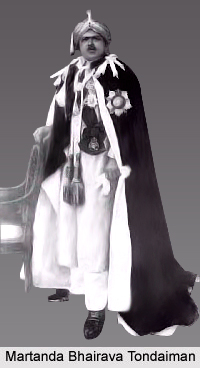 Martanda Bhairava Tondaiman, formally known as His Highness Raja Sri Brahdamba Dasa Raja Sir Martanda Bhairava Tondaiman GCIE, was the ruler or Raja of the princely state of Pudukkottai, which is currently located in the present district of Pudukkottai in Tamil Nadu. He reigned over the region from the period 15th April 1886 to 28th May 1928. The prominent ruler was born on 26th November 1875 to the parents M.R. Ry. Kolandaswami Pallavarayar Sahib Avargal and his wife Princess Brihadambal Rajammani Sahib of Pudukkottai. His mother was the eldest daughter of the Raja of Pudukkottai, Ramachandra Tondaiman. As Raja Ramachandra Tondaiman did not have any son of his own and lacked a male heir, thus he adopted Martanda Bhairava when he was still in an early age.
Martanda Bhairava Tondaiman, formally known as His Highness Raja Sri Brahdamba Dasa Raja Sir Martanda Bhairava Tondaiman GCIE, was the ruler or Raja of the princely state of Pudukkottai, which is currently located in the present district of Pudukkottai in Tamil Nadu. He reigned over the region from the period 15th April 1886 to 28th May 1928. The prominent ruler was born on 26th November 1875 to the parents M.R. Ry. Kolandaswami Pallavarayar Sahib Avargal and his wife Princess Brihadambal Rajammani Sahib of Pudukkottai. His mother was the eldest daughter of the Raja of Pudukkottai, Ramachandra Tondaiman. As Raja Ramachandra Tondaiman did not have any son of his own and lacked a male heir, thus he adopted Martanda Bhairava when he was still in an early age.
Early Life of Martanda Bhairava Tondaiman
Martanda Bhairava Tondaiman was the third son of Princess Brihadambal. He was privately educated by Feilden Crossley, who was an alumnus of University of Cambridge. Apart from studies, the ruler of the princely state of Pudukkottai also excelled in sports. Moreover, he preferred European culture, conduct and literature. After the death of the former Raja of Pudukkottai, Ramachandra Tondaiman who ruled for around 50 years, on 15th April 1886, Martanda Bhairava Tondaiman succeeded him and became the crowned king of the princely state of Pudukkottai, when he was merely 11 years of age.
Raja Sri Sir Martanda Bhairava Tondaiman ruled and administered under the guidance of Diwan A. Seshayya Sastri, who served as the Regent, as the ruler was still a minor. After he attained the age of majority, Martanda Bhairava Tondaiman was invested with full ruling powers by the Governor of Madras, Lord Wenlock. He assumed the reign of the administration and government of the princely state of Pudukkottai on 27th November 1894.
Rule of Martanda Bhairava Tondaiman
After His Highness Raja Sri Sir Martanda Bhairava Tondaiman GCIE took over the administration and management of the princely state of Pudukkottai, he petitioned for the compensation and restoration of the Manovarti Jagir. In the early 19th century, the jagir was assigned by Raja Vijaya Raghunatha Tondaiman of Pudukkottai as the private property of his 3 wives. The Manovarti Jagir comprised of four separate villages. As Martanda Bhairava did not have any wives and was unmarried at the time, he preferred that the property be restituted to him, but the British Government of India rejected his request.
In the year 1902, Martanda Bhairava Tondaiman established a representative assembly of 30 members on the model of the Mysore Assembly. The members of the assembly were nominated by heads of government departments and public institutions. The office of Councilor was formed to provide support to the Diwan and the Diwan acting with the assistance of the Councillor was officially known as Diwan in Council. During the reign of Martanda Bhairava Tondaiman over the princely state of Pudukkottai, he attended the Coronation Durbar that was held at Delhi in the year 1903. He was also present at the coronation of George V conducted at Westminster Abbey in the year 1911.
Personal Life of Martanda Bhairava Tondaiman
Martanda Bhairava Tondaiman was married to Australian socialite Molly Fink on 10th August, 1915 at the Regsitrar`s Office in Melbourne, Australia. The couple met in March 1915 at the Hotel Majestic Mansions, Melbourne and later the Raja of the princely state of Pudukkottai proposed to her in August 1915. The royal couple had a son named Martanda Sydney Tondaiman, who was born on 22nd July 1916.
As the British administration in India refused to recognize Molly Fink as the Maharani of Pudukkottai and was hostile to their marriage, the royal couple relocated to Australia and resided there from the year 1916 to 1919. Later they moved to London and finally to Cannes, France. Martanda Bhairava renounced the royal throne of Pudukkottai in 1921 and nominated Raghunatha Pallavarayar, his brother, to administer the princely state in his absence. Raja Sri Sir Martanda Bhairava Tondaiman settled in France with his wife Molly and his son Martanda Sydney. He died at the age of 52, on 28th May 1928. As the India Office refused the request of his wife to transport his body to India by airway, Martanda Bhairava was cremated and the ashes were laid to rest at the Golders Green Crematorium in London.
Martanda Bhairava Tondaiman, Raja of Pudukkottai, was succeeded by Rajagopala Tondaiman, his 6 year old nephew. As he was still a minor, he ruled over the territory under Raghunatha Pallavarayar, who served as the regent of the state.
Honours of Martanda Bhairava Tondaiman
His Highness Raja Sri Brahdamba Dasa Raja Sir Martanda Bhairava Tondaiman GCIE was appointed as a Knight Grand Commander of the Order of the Indian Empire in the 1913 New Year Honours List by the British Government of India.



















